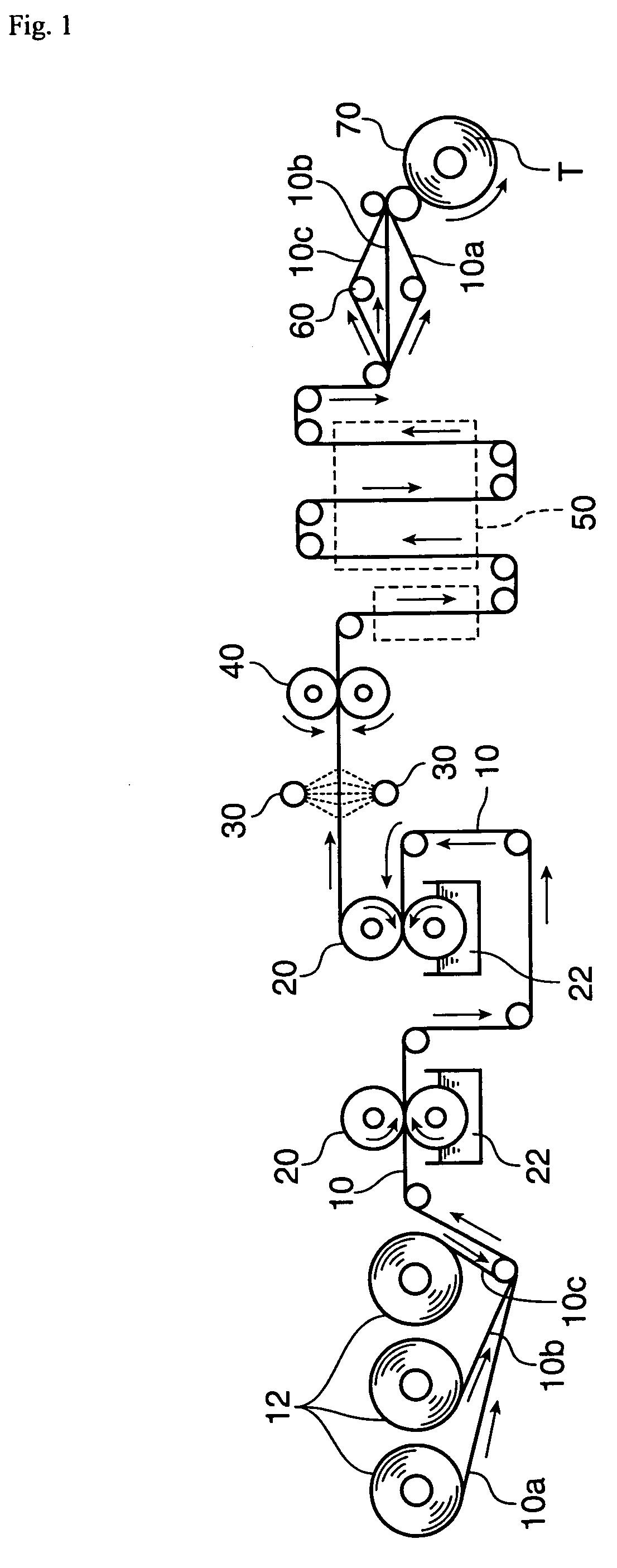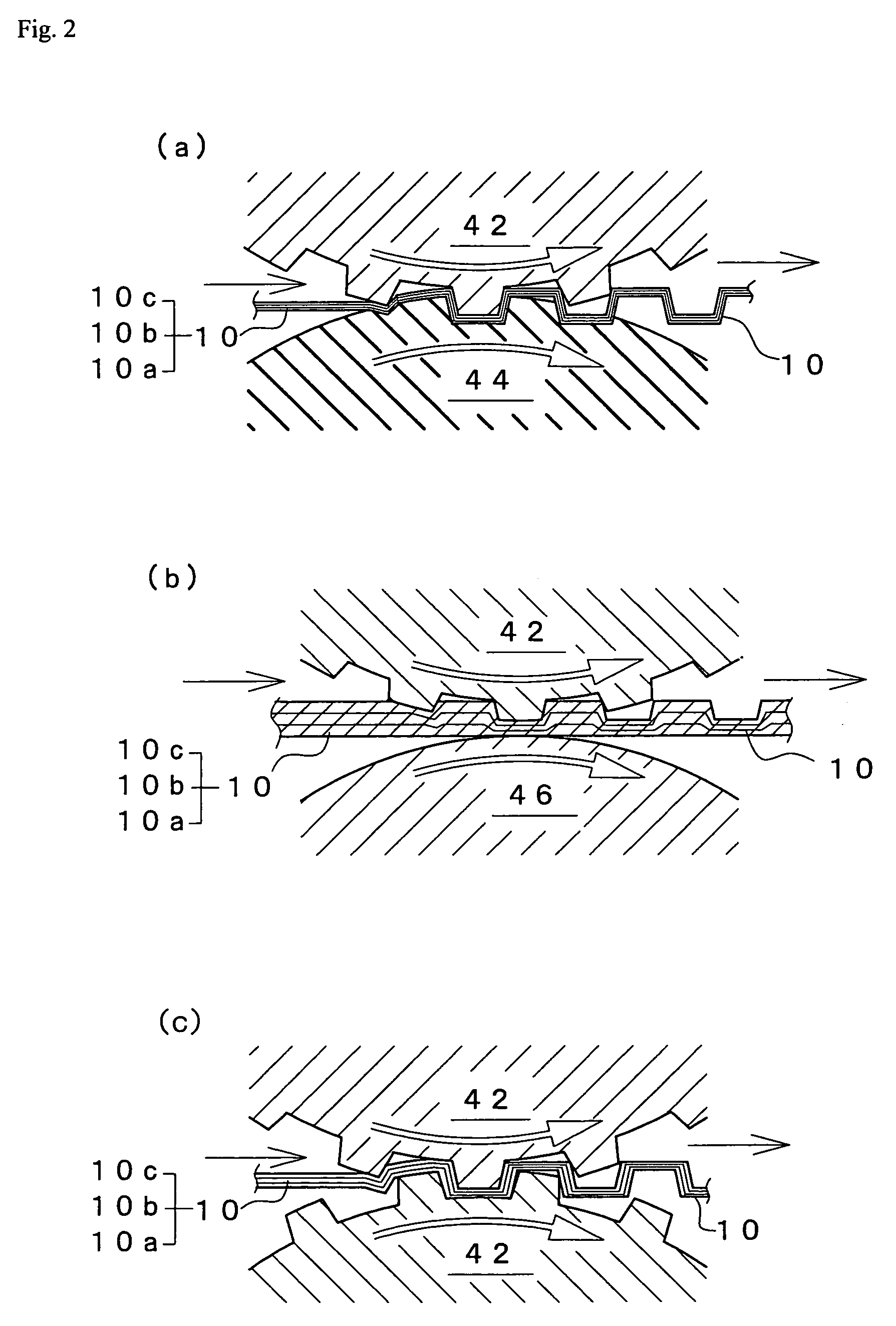Embossed crepe paper and its manufacturing method
a crepe paper and embossed technology, applied in the field of embossed crepe paper, can solve the problems of fibers themselves being broken, fibers not being smoothly moved by each other, fibers fixed to each other by hydrogen bonding, etc., and achieves the destruction of hydrogen bonding between fibers, spoiled raw crepe paper properties, and deterioration of strength. a small
- Summary
- Abstract
- Description
- Claims
- Application Information
AI Technical Summary
Benefits of technology
Problems solved by technology
Method used
Image
Examples
example 1
Raw Crepe Paper
[0225]A pulp material comprising a combination of 60 weight % of LBKP (bleached pulp gained in accordance with a hardwood kraft method) and 40 weight % of NBKP (bleached pulp gained in accordance with a softwood kraft method) was beaten so as to have a Canadian standard freeness of 620 ml to 630 ml, and then 0.2 weight % (relative to the pulp material) of a wet paper strength agent was added, and then a raw crepe paper was made in accordance with a conventional method.
[0226]The gained raw crepe paper had a basis weight of 13 g / m2 and a crepe ratio of 18%.
[0227]:
[0228]The dry-conditioned raw crepe paper was made into two-ply, and the amount of water listed in the following Table was sprayed onto the surface of the raw crepe paper and thereby absorbed. As for the amount of water supplied, its weight based on the weight of the raw crepe paper was shown in %.
[0229]The wet-conditioned raw crepe paper was embossed. For the embossing, an embossing apparatus having an embossi...
example 2
Moisture-Retaining Tissue
Two-Ply
[0245]A paper for manufacturing a moisture-retaining tissue “Avonlea Keith” (trade name, made by Kawano Paper Co., Ltd.) was used, wherein the paper was manufactured by making the same raw crepe paper as of the above described Example 1 into two-ply and then supporting thereon a moisture-retaining component. This moisture-retaining paper for tissue has a basis weight of 12.7 g / m2 before the moisture-retaining processing and a basis weight of 15.6 g / m2 after the moisture-retaining processing.
[0246]The moisture-retaining component comprises glycerol and sorbitol. In addition, the moisture-retaining liquid for supplying the moisture-retaining component also included water, but the raw crepe paper was left for a sufficient period of time after the moisture-retaining liquid was supplied thereto. As a result, the moisture-retaining paper for tissue is in a state where moisture being in a state of equilibrium with moisture in the environment is included in t...
example 3
Moisture-Retaining Tissue
Three-Ply
[0259]A paper, comprising a three-ply raw crepe paper, for manufacturing a moisture-retaining tissue “Fu-fu-fu” (trade name, made by Kawano Paper Co., Ltd.) was used. This paper has a basis weight of 11.0 g / m2 before the moisture-retaining processing and a basis weight of 12.0 g / m2 after the moisture-retaining processing.
[0260]:
[0261]An embossed moisture-retaining tissue was gained via the steps common to Example 2. The same tests as those for Example 1 were performed about the manufactured embossed moisture-retaining tissue.
PUM
| Property | Measurement | Unit |
|---|---|---|
| height | aaaaa | aaaaa |
| temperature | aaaaa | aaaaa |
| weight % | aaaaa | aaaaa |
Abstract
Description
Claims
Application Information
 Login to View More
Login to View More - R&D
- Intellectual Property
- Life Sciences
- Materials
- Tech Scout
- Unparalleled Data Quality
- Higher Quality Content
- 60% Fewer Hallucinations
Browse by: Latest US Patents, China's latest patents, Technical Efficacy Thesaurus, Application Domain, Technology Topic, Popular Technical Reports.
© 2025 PatSnap. All rights reserved.Legal|Privacy policy|Modern Slavery Act Transparency Statement|Sitemap|About US| Contact US: help@patsnap.com



